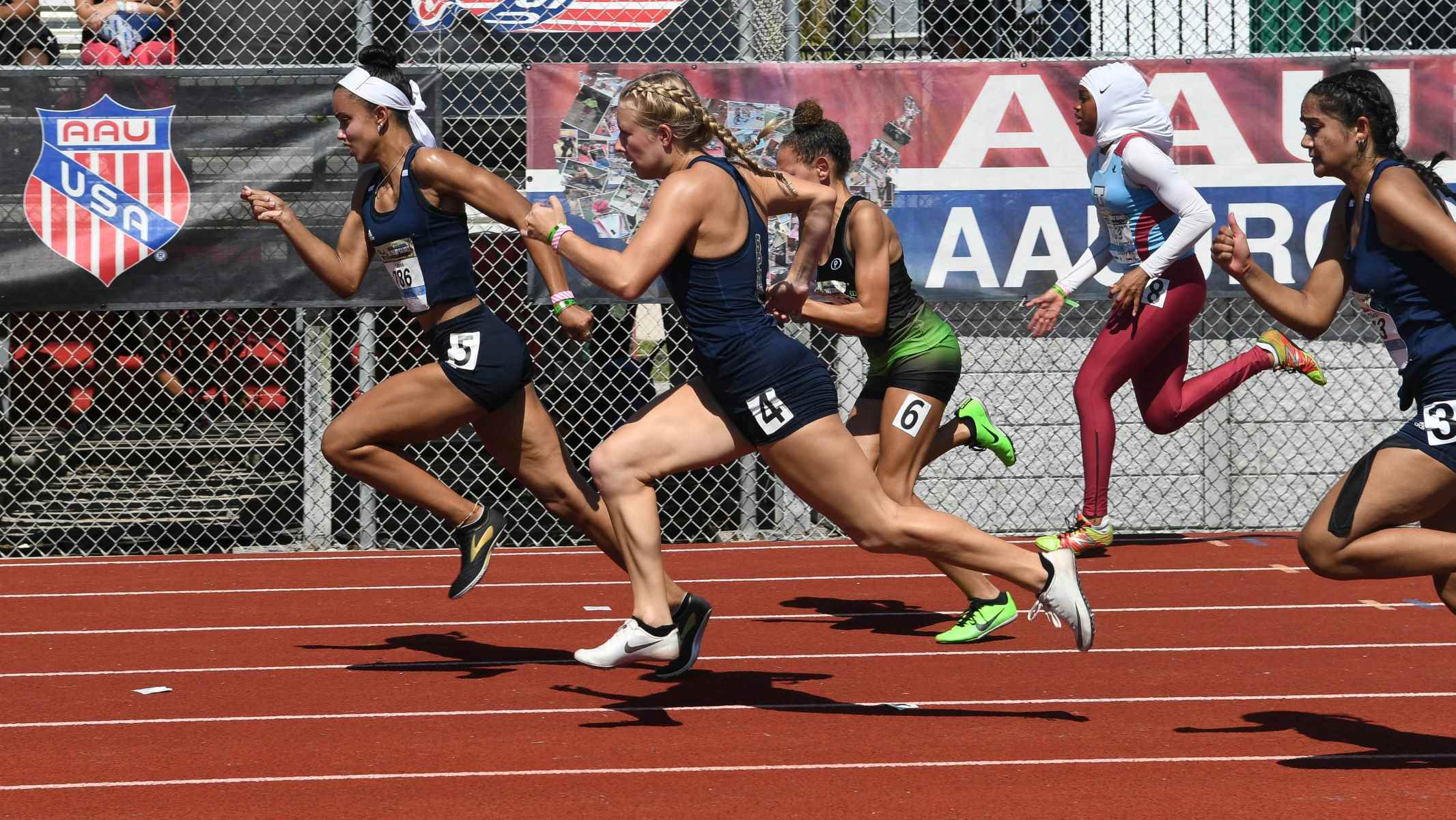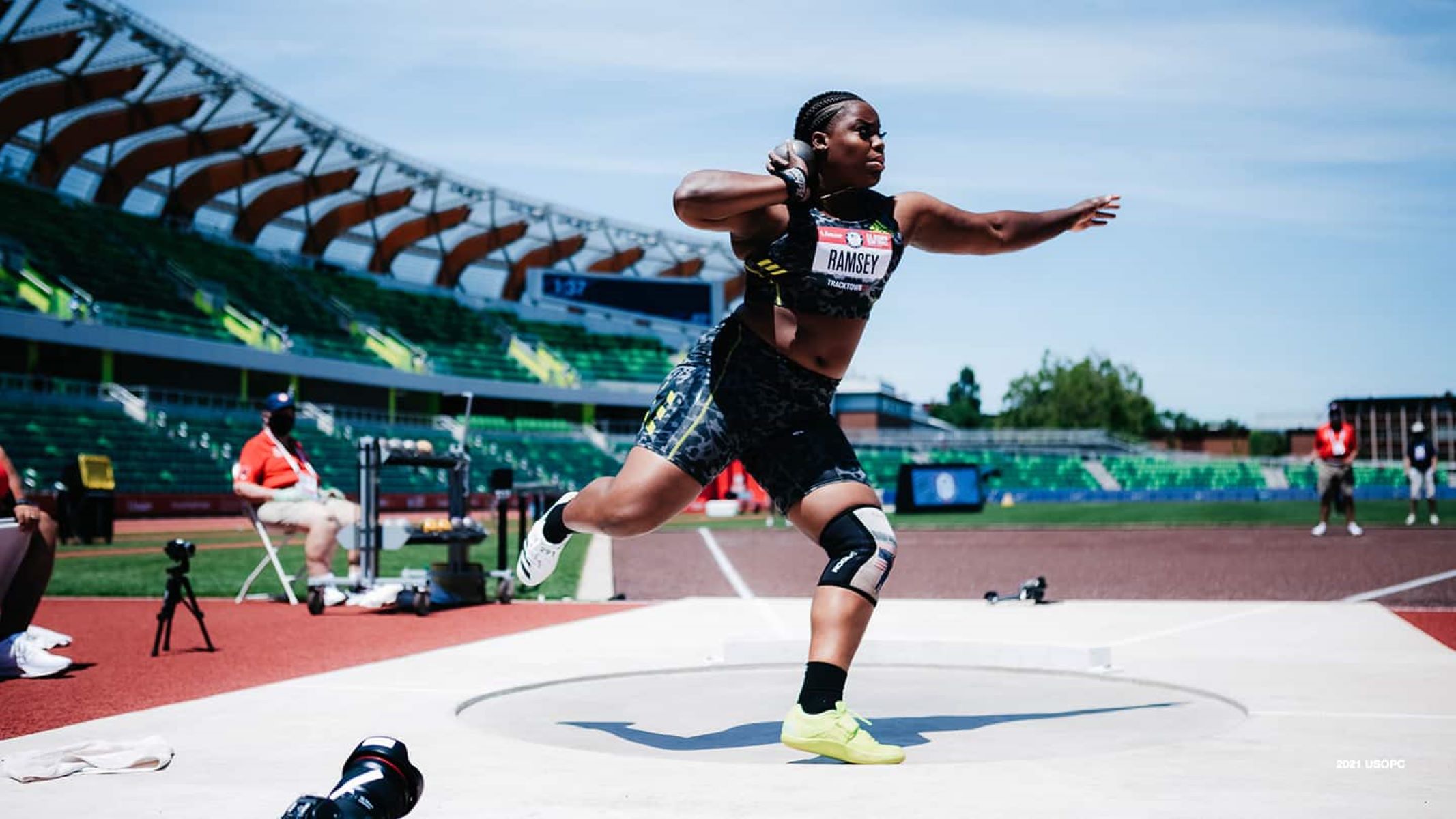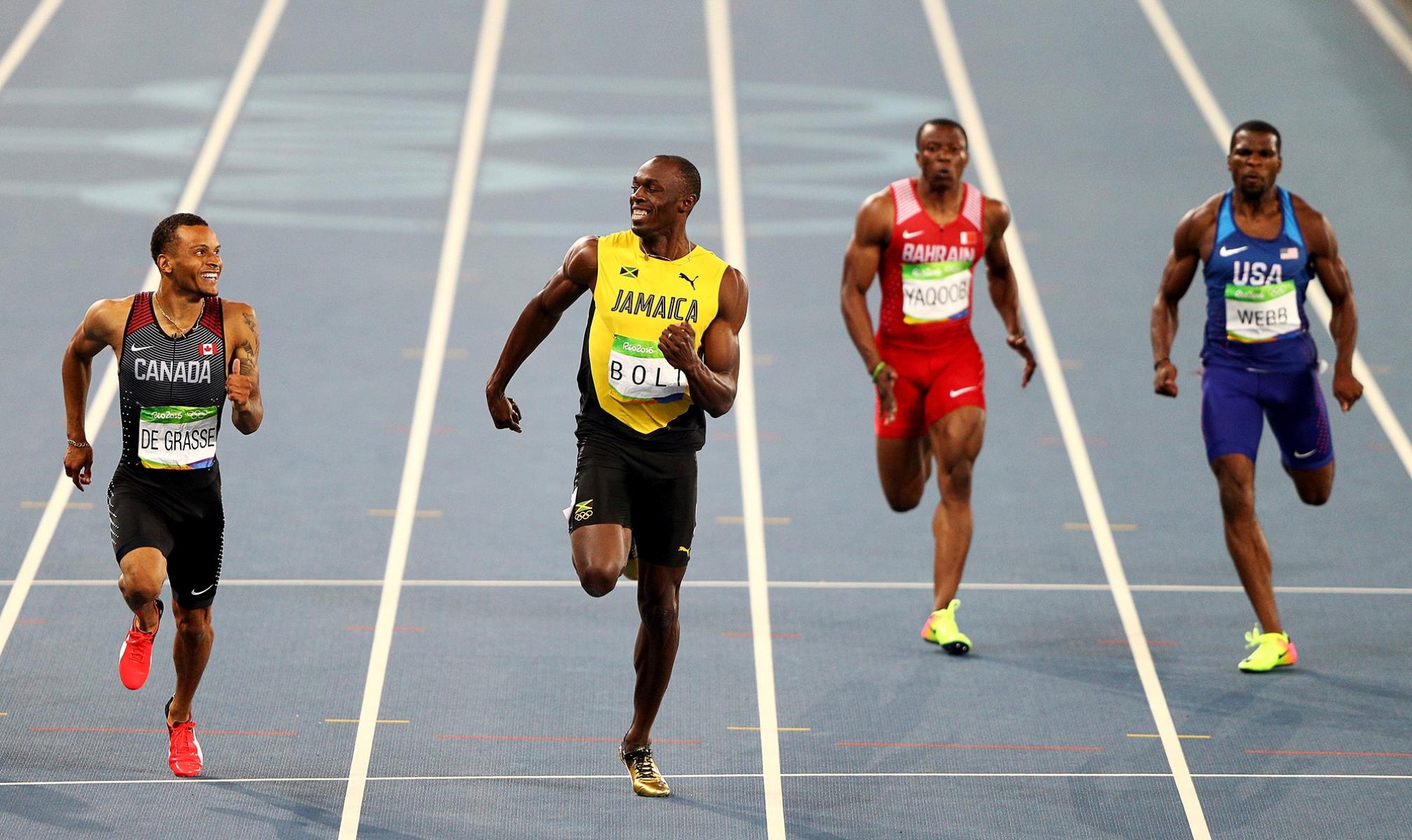

Featured
What Do You Throw In Track And Field
Modified: January 2, 2024
Discover the top throwing events in track and field. From shot put to discus and more, get featured tips and techniques to excel in these exciting disciplines.
Introduction
Welcome to the exciting world of track and field! A sport that combines speed, strength, and skill, track and field is a showcase of human athleticism and determination. From sprinting to throwing, jumping to vaulting, track and field offers a wide range of thrilling events that captivate both athletes and spectators alike.
Track and field has a rich history dating back to ancient civilizations, where athletes would compete to showcase their physical prowess and honor their respective countries. Today, it has evolved into an internationally recognized sport with events contested at various levels, from local school competitions to the Olympic Games.
One of the fascinating aspects of track and field is the diverse range of events it encompasses. From the explosive power of shot put and hammer throw to the graceful technique of high jump and pole vault, each discipline requires a unique set of skills and techniques. In this article, we will explore some of the most famous track and field events and delve into the equipment used and techniques employed by athletes.
Whether you are a track and field enthusiast looking to broaden your knowledge or a newcomer curious about the sport, this article will provide you with a comprehensive overview of the different events in track and field. So, let’s dive in and discover what is thrown in track and field!
Shot Put
The shot put is a classic throwing event in track and field that dates back to ancient Greece. It requires athletes to put (or throw) a heavy spherical object called a shot as far as possible. The shot, typically made of metal or steel, weighs different amounts depending on the gender and age group of the competitors.
In a shot put competition, athletes enter a throwing circle and take a standing or glide technique to propel the shot forward. The standing technique involves a stationary position while pushing the shot from the shoulder, while the glide technique involves a dynamic movement where the athlete glides across the circle before releasing the shot.
The key to success in shot put lies in a combination of strength, speed, and technique. Athletes need great lower body strength to generate power and explosiveness during the throw. They also require excellent upper body strength to control the shot and deliver it with precision.
The technique used in shot put is crucial for maximizing distance. Athletes must maintain balance and proper body alignment while transferring force from the legs to the upper body during the throw. It requires a coordinated movement of the legs, hips, shoulders, and arms to generate the necessary power and release the shot at the optimal angle.
Shot put competitions are measured by the distance traveled by the shot from the point of release to where it lands in the throwing sector. The athlete who achieves the greatest distance is declared the winner. In addition to strength and technique, factors such as speed, body size, and timing are also essential in determining the outcome of the event.
The shot put is one of the most intense and thrilling events in track and field. Athletes aim to push the limits of their physical abilities and achieve personal bests every time they step into the throwing circle. It requires not only strength and power, but also mental focus and determination. Whether you’re a participant or a spectator, the shot put is sure to keep you on the edge of your seat as you witness athletes launch the shot into the distance.
Discus Throw
The discus throw is another fascinating throwing event in track and field that showcases the combination of strength, agility, and technique. Dating back to ancient times, the discus throw involves athletes launching a heavy disc-shaped object known as a discus as far as possible.
In a discus throw competition, athletes enter a throwing circle and use a spinning technique to generate momentum and release the discus. The throw begins with the athlete facing away from the direction of the throw, spinning rapidly before releasing the discus at the optimal angle.
The discus used in competitions varies in weight depending on the gender and age group of the competitors. It is traditionally made of metal, although modern versions may utilize composite materials. The discus has a smooth outer rim and a weighted center, allowing it to maintain stability during flight.
Success in the discus throw requires a combination of physical strength, rotational speed, and proper technique. Athletes must have strong core and lower body muscles to generate a powerful rotational force. They also need exceptional coordination and balance to maintain control throughout the spinning motion.
The technique in discus throw involves a series of coordinated movements. Athletes must transfer their weight from leg to leg while maintaining balance and generating centrifugal force through rapid spins. The proper release of the discus at the right time and angle is crucial for achieving maximum distance.
Discus throw competitions are measured by the distance achieved by the discus from the point of release to where it lands in the throwing sector. Athletes aim to achieve the greatest distance possible through a combination of strength, technique, and timing. The competitor who achieves the longest throw is declared the winner.
Watching a discus throw can be awe-inspiring, as athletes unleash both power and precision in their quest for distance. The graceful spins combined with the explosive release of the discus make it a visually captivating event. Whether you’re an athlete participating in the discus throw or a spectator cheering on the competitors, this event is sure to leave you amazed at the incredible abilities displayed on the field.
Javelin Throw
The javelin throw is a thrilling and ancient event in track and field that showcases the combination of strength, technique, and precision. Dating back to the ancient Olympic Games, the javelin throw involves athletes propelling a long spear-like object known as a javelin as far as possible.
In a javelin throw competition, athletes enter a runway and launch the javelin using an overhead throwing technique. The throw begins with the athlete building up speed by running down the runway. As they approach the designated throwing area, they use their full body strength to propel the javelin forward, releasing it at the right moment for maximum distance.
The javelin used in competitions is typically made of metal or fiberglass and has a pointed tip for aerodynamic efficiency. The length and weight of the javelin differ depending on the gender and age group of the competitors. Proper grip and balance are key factors in the success of a javelin throw, as they allow the athlete to control the javelin during the throwing motion.
Success in the javelin throw relies on a combination of strength, speed, and technique. Athletes need explosive lower body power to generate speed and momentum during the run-up. They also require strong arm and shoulder muscles to deliver the javelin with force and accuracy.
The technique used in javelin throw is crucial for achieving maximum distance. Athletes must coordinate their body movements to transfer energy from the run-up to the release of the javelin. The correct timing and release angle are essential to optimize the javelin’s flight and achieve a longer throw.
Javelin throw competitions are measured by the distance achieved by the javelin from the point of release to where it lands in the throwing sector. Athletes aim to achieve the longest throw possible by combining their physical abilities with proper technique. The competitor who achieves the greatest distance is declared the winner.
Watching a javelin throw is a mesmerizing experience, as athletes gracefully sprint down the runway before launching the javelin into the sky. The power and precision displayed in this event are awe-inspiring, leaving spectators in awe of the athletes’ skill and determination.
Whether you’re an athlete participating in the javelin throw or a spectator enjoying the event, the javelin throw is sure to captivate your attention with its combination of strength, speed, and technique.
Hammer Throw
The hammer throw is a unique and captivating event in track and field that requires immense strength, agility, and technique. Originating from Scotland, the hammer throw involves athletes throwing a heavy metal ball, called a hammer, as far as possible.
In a hammer throw competition, athletes enter a throwing circle and use a series of spins to generate momentum before releasing the hammer. The throw begins with the athlete swinging the hammer around their head in a circular motion, building up speed and centrifugal force. The release of the hammer is timed to maximize distance.
The hammer used in competitions consists of a metal ball attached to a steel wire and handle. The weight and length of the hammer vary depending on the gender and age group of the competitors. Athletes must have a strong grip and proper control of the hammer during the throwing motion.
Success in the hammer throw requires a combination of strength, technique, and timing. Athletes must have powerful core and upper body muscles to generate the momentum and speed needed for a successful throw. They also need exceptional coordination and balance to maintain control throughout the spinning motion.
The technique used in the hammer throw is crucial for achieving maximum distance. Athletes must coordinate their footwork, body movements, and the swinging motion of the hammer to generate the greatest amount of speed and force. The release of the hammer at the optimal angle is key to achieving longer throws.
Hammer throw competitions are measured by the distance achieved by the hammer from the point of release to where it lands in the throwing sector. Athletes aim to achieve the greatest distance possible through a combination of strength, technique, and timing. The competitor who achieves the longest throw is declared the winner.
Watching a hammer throw is a spectacle of power and precision. Athletes skillfully harness their strength and channel it into the hammer, propelling it into the air with impressive force. The graceful spins combined with the explosive release make the hammer throw a thrilling event for both athletes and spectators.
Whether you’re an athlete participating in the hammer throw or a spectator witnessing the event, the combination of strength and technique displayed in this event is sure to leave you in awe of the athletes’ abilities.
High Jump
The high jump is a captivating and challenging event in track and field that showcases athletes’ ability to leap over a horizontal bar at great heights. It is a true test of athleticism, combining agility, speed, and technique.
In a high jump competition, athletes approach a curved track known as the approach run. They use the momentum from the approach run to propel themselves vertically over the bar. The bar is suspended between two standards and can be adjusted to different heights throughout the competition.
Success in the high jump requires a combination of physical attributes and proper technique. Athletes need explosive lower body power and strong leg muscles to generate upward momentum. They also require good flexibility and coordination to execute the correct technique and achieve the desired height.
The technique used in the high jump has evolved over the years, with various styles used to clear the bar. The most common technique is the Fosbury Flop, named after American athlete Dick Fosbury. In this technique, the jumper approaches the bar diagonally and clears it by arching their back and raising their legs backwards over the bar.
Another technique is the straddle technique, where the jumper approaches the bar head-on and clears it by going up and over in a forward-facing position, with the body parallel to the bar. This technique requires precise timing and coordination to clear the height successfully.
High jump competitions are measured by the height cleared by the athletes. The competition continues until all athletes but one are eliminated, or if a set number of rounds have been completed. The winner is the athlete who clears the highest height without knocking the bar off the standards.
Watching a high jump event is both exhilarating and nerve-wracking. The suspense builds as athletes strive to clear higher heights, with each jump becoming more challenging than the last. The combination of athleticism, technique, and determination displayed by high jumpers makes it a favorite event among track and field enthusiasts.
Whether you’re an athlete competing in the high jump or a spectator cheering on the participants, witnessing the grace and sheer athleticism required for this event is truly awe-inspiring.
Pole Vault
The pole vault is an electrifying event in track and field that requires both physical strength and exceptional technique. It is a sport where athletes use a flexible pole to propel themselves over a high bar, showcasing their incredible agility and acrobatic skills.
In a pole vault competition, athletes have a designated runway to build up speed and momentum. They carry a long and flexible pole as they approach the vaulting box, a specially designed area where they plant the pole to propel themselves into the air. The objective is to clear the bar without knocking it off the standards.
The pole used in vaulting is typically made of fiberglass or carbon fiber. The length and stiffness of the pole may vary depending on the athlete’s preference and skill level. Athletes must possess strength, speed, and technique to utilize the pole’s energy and achieve greater heights.
Success in pole vaulting requires a combination of physical attributes and technical skill. Athletes need explosive lower body power and upper body strength to generate the necessary speed and momentum. They also need precise coordination and timing to execute the planting of the pole and the subsequent launch over the bar.
The technique used in pole vaulting is crucial for clearing high heights. Athletes must have a smooth approach run, focusing on maintaining speed and a steady rhythm. As they plant the pole in the vaulting box, they must generate the right amount of vertical force to propel themselves upwards and over the bar with finesse.
Pole vault competitions are measured by the height cleared by the athletes. If multiple athletes clear the same height, the winner is determined based on the fewest number of attempts needed to clear that height. In some cases, a jump-off may be required to determine the ultimate winner.
Watching a pole vault event is a thrilling experience. The combination of speed, power, and technique exhibited by athletes as they soar through the air is truly mesmerizing. The tension mounts as the bar is raised, and it becomes a battle of nerves and precision as each vaulter tries to clear greater heights.
Whether you’re an athlete participating in the pole vault or a spectator witnessing the event, the skill and athleticism displayed in this event are bound to leave you in awe of the human potential and the heights that can be achieved.
Long Jump
The long jump is a thrilling and dynamic event in track and field that showcases an athlete’s explosive speed, power, and jumping ability. It is a test of both athleticism and technique, where competitors aim to achieve the greatest distance from a running start into a sand pit.
In a long jump competition, athletes begin by taking a running start down a runway. As they approach a designated takeoff area, they prepare to launch themselves into the air. The goal is to jump as far as possible, landing in a sand-filled pit that marks the end of the jump.
The technique used in the long jump is essential for maximizing distance. Athletes need a powerful and well-timed takeoff to generate vertical momentum. They also need to execute proper body positioning throughout the jump to achieve the ideal flight trajectory. The ability to control and coordinate their movements during the jump is crucial for a successful long jump.
Success in the long jump requires a combination of physical strength, speed, and technique. Athletes must have explosive lower body power to generate speed and height during takeoff. They also need good timing and coordination to execute a smooth transition from the takeoff to the flight phase.
The landing is another critical aspect of the long jump. Athletes must have the agility and technique to land safely and efficiently in the sand pit without losing valuable distance. Proper body positioning and landing mechanics help minimize any loss of momentum and ensure a legal and effective jump.
Long jump competitions are measured from the takeoff point to the closest point of contact in the sand pit. Athletes aim to achieve the greatest distance possible with their jump. If multiple athletes achieve the same distance, the winner is determined based on the second-best jump or, if necessary, a jump-off.
Watching a long jump event is a thrilling experience, with athletes sprinting down the runway before launching themselves into the air with incredible athleticism. The tension builds as each competitor aims to improve their previous jump and strive for a new personal best or even a record-breaking jump.
Whether you’re an athlete participating in the long jump or a spectator witnessing the event, the combination of speed, power, and skill displayed in this event is truly awe-inspiring.
Triple Jump
The triple jump is an exhilarating and technically demanding event in track and field that combines speed, power, and agility. As its name suggests, it involves a sequence of three consecutive jumps: the hop, the step, and the jump. The triple jump is a true test of an athlete’s athleticism, coordination, and technique.
In a triple jump competition, athletes begin by sprinting down a runway with the intention of achieving maximum speed. As they approach a designated takeoff point, they perform the hop, which involves jumping off one foot and landing on the same foot. From there, they transition into the step phase, where they take a single step on the opposite foot. Finally, they execute the jump phase, launching themselves into the air and landing in a sand-filled pit.
The triple jump requires a unique combination of explosive power, technique, and precise body positioning. Athletes must have excellent lower body strength to generate speed and power during the initial hop. They also need exceptional coordination and rhythm to smoothly transition from one phase to the next.
Proper technique is essential in the triple jump to maximize distance and maintain control throughout the jumps. Athletes must ensure a quick and efficient transition from the hop to the step, maintaining momentum and balance. In the jump phase, they need to execute proper takeoff mechanics, including a powerful extension of the leg and a well-timed jump movement, to propel themselves as far as possible.
Triple jump competitions are measured from the takeoff line to the closest mark in the sand pit. The athlete’s total distance is the sum of the individual distances achieved in each phase of the jump. The competitor who achieves the longest total distance is declared the winner.
Watching a triple jump event is a spectacle of athleticism, as athletes showcase their explosive power and agility in the runway. The sequence of consecutive jumps keeps spectators on the edge of their seats, marveling at the grace and precision displayed by the competitors.
Whether you’re an athlete participating in the triple jump or a spectator witnessing the event, the triple jump is sure to captivate your attention with its combination of speed, power, and technical skill.
Discussing Other Track and Field Events
While the shot put, discus throw, javelin throw, hammer throw, high jump, pole vault, long jump, and triple jump are some of the most well-known events in track and field, the sport is filled with other exciting disciplines that showcase a variety of athletic abilities and skills.
Sprinting events, such as the 100-meter, 200-meter, and 400-meter races, test an athlete’s speed and power. These short-distance races require explosive acceleration and efficient running mechanics to achieve victory. The relay races, including the 4×100-meter and 4×400-meter relays, add an element of teamwork, as athletes pass a baton to one another in a fast-paced, exciting display of speed and coordination.
Mid-distance and distance races, such as the 800-meter, 1500-meter, and 5000-meter races, challenge an athlete’s endurance and strategy. These races require a combination of speed and stamina, as competitors pace themselves while aiming for the finish line. The 3000-meter steeplechase adds an additional hurdle element, with athletes clearing water barriers throughout the race.
Hurdling events, including the 110-meter and 400-meter hurdles, combine speed, agility, and the ability to navigate over a series of evenly spaced hurdles. Athletes must display precise technique and timing as they rhythmically clear each hurdle while maintaining a strong stride.
The 400-meter individual medley, a discipline in track and field, combines four different strokes: butterfly, backstroke, breaststroke, and freestyle. In this event, athletes display versatility by swimming each stroke for a designated distance. The individual medley requires a balance of speed, strength, and technical proficiency across multiple swimming styles.
The decathlon (for men) and heptathlon (for women) are multi-event competitions that span across two days. Athletes compete in ten (decathlon) or seven (heptathlon) different events, which include sprints, jumps, throws, and middle-distance races. The combined scores from each event determine the ultimate winner, showcasing the versatility and overall athleticism of the competitors.
These are just a few examples of the many exciting events in track and field. From sprints to jumps, throws to hurdles, and everything in between, track and field offers a wide range of disciplines that cater to athletes with different strengths and skills.
Whether you prefer the explosive power of throws, the graceful technique of jumps, the lightning-fast speed of sprints, or the strategic endurance of distance events, track and field has something for everyone to enjoy. So, take the time to delve into the world of track and field and explore the incredible athleticism and diversity of events in this exhilarating sport.
Conclusion
Track and field is a sport that truly embodies the essence of athleticism and human potential. From the explosive power of the shot put and hammer throw, to the grace and precision of the high jump and pole vault, each event showcases the incredible abilities of athletes in various disciplines.
Whether you’re a participant or a spectator, track and field offers a captivating experience. The adrenaline rush of sprinting down the track, the anticipation of the throw or jump, and the sheer display of strength and skill make this sport a thrilling spectacle to behold.
Each event in track and field requires a unique set of physical attributes, techniques, and strategies. Whether it’s the explosiveness of the throwing events, the agility and technical finesse of the jumping events, or the raw speed and endurance of the running events, athletes must hone their skills to excel in their chosen disciplines.
Track and field events not only showcase individual talent and accomplishments but also promote camaraderie, teamwork, and friendly competition through relay races and multi-event competitions. The sport brings athletes from diverse backgrounds and various parts of the world together, fostering a global community united by the love of running, jumping, and throwing.
Whether you’re an athlete participating in track and field, a casual observer, or a fervent supporter, being a part of this sport is a testament to the human spirit’s ability to push boundaries and achieve greatness.
So, next time you watch a track and field event, take a moment to appreciate the dedication, hard work, and passion that athletes pour into their performances. Celebrate the thrilling moments, the remarkable achievements, and the timeless spirit of track and field that continues to inspire and captivate us all.









